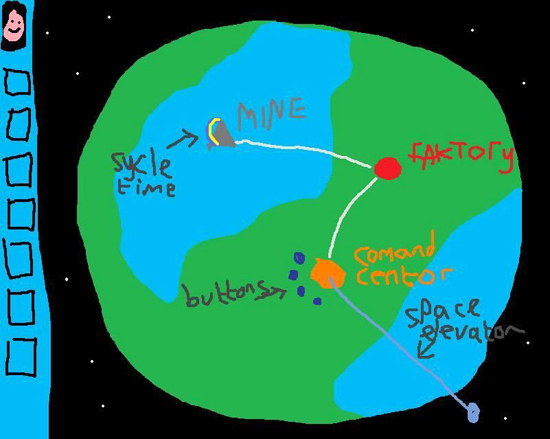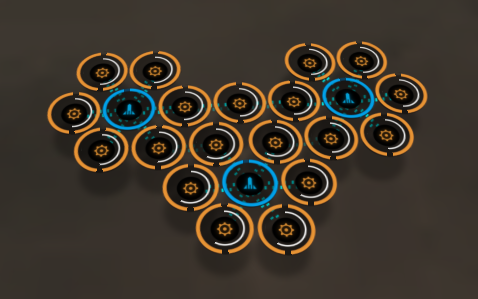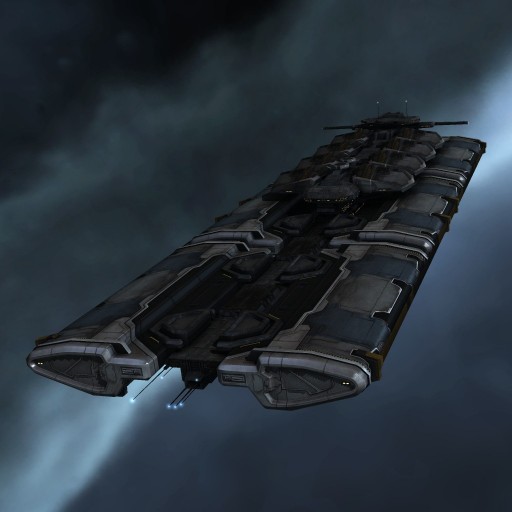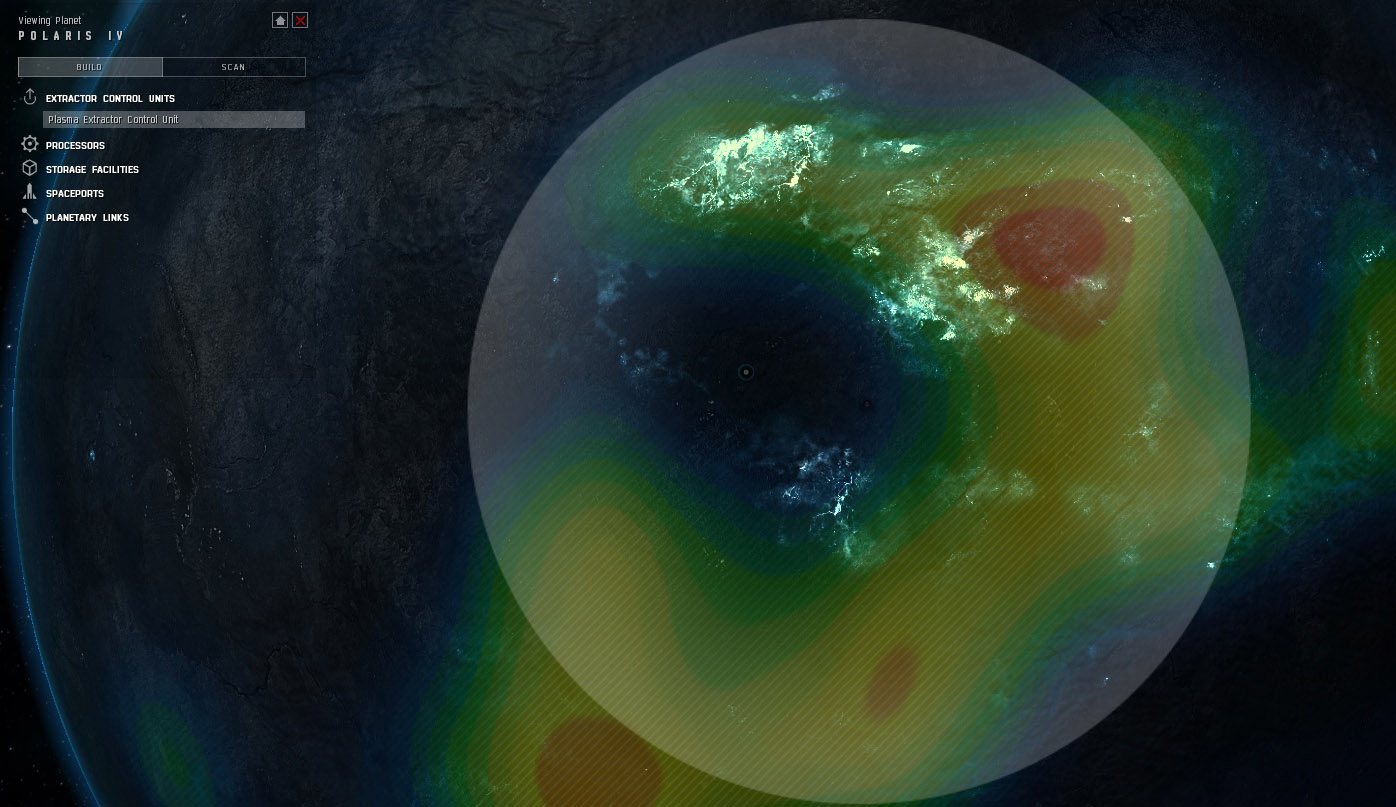
What is Planetary Interaction?
Planetary Interaction was introduced with the Tyrannis Expansion. At its core Planetary Interaction (PI for short) is a mingame based around passively generated resources from planets. Since planets exist in all systems of New Eden, you can do it in any system. There has been a few systems that has been locked for PI due to server load and Lore Issues, but outside of these very few systems any planet that has resources can be used.
What is the purpose of Planetary Interaction?
The purpose becomes clear when you look at the resource requirements to build and fuel starbases. Some of the products are used for fuel consumption (combined to create fuel blocks) while others are used in producing starbases or starbase components. In short, one does not simply create and maintain a starbase. This means that for some of the PI products there is a large demand, while for others, its a miniscule demand. Fuel components, are in high demand while the remaining are quite a bit lower in regular volume demand. Since it takes so much to destroy starbases, they are usually built to feed the needs of upcoming capsuleers, or during long term war campaigns in null-security space.
An increase in demand for starbase components require destruction or player influx, while for POS fuel components it merely requires the presence of starbases. With more starbases comes more demand. Currently it takes 6720 Fuel Blocks to fuel a large player owned starbase which turns out to be …
- 1344 x Coolant
- 672 x Enriched Uranium
- 672 x Mechanical Parts
- 3360 x Oxygen
- 168 x Robotics
Medium towers, are half of that and small towers are half of the mediums. It doesn’t take “Rocket Science V” to realize that while there may be demand for PI material that goes into the creation of a starbase, the demand for POS fuel is much higher.
There are planets that don’t have resources?
Yes. The Shattered Planet Type does not support PI because it does not produce any resources. You can also not find a Command Centre for that planet type (see below). Similarly, some systems are locked for PI due to traffic and/or lore issues.

It am teh hard?
PI requires only that you have enough cargo hold to place a Command Centre of choice, really. Any additional skills simply further build on the core principle – resource aquisition. This works either by allowing you to see more details of where the resources are placed (so you can place the extractor the correct place for more yield) or allow you to increase the number of planetary structures – and thus either reduce the volume of the products for a increase in profit per product or help with logistics.
As with anything though, it gets more hairy once you really try to maximize the potential of it and can take some planning, research and risk.
Be aware that as a first timer, the Command Centres cost ISK, updating them also cost ISK, exporting your goods from the planet cost ISK and finally your hauler cost ISK. There are some initial investment involved before you start making money.
What is the basic process?
You basically start with 1 Command Centre on your planet of choice. The planet type defines the type of Command Centre you can get. There are 8 basic types to chose from that is based on planet type. You expand your planetary structure (this cost money) by adding extractors, storage facilities and industrial factory type buildings. You set up your chain of production and start extracting resources to feed your facilities so they can make products for export.
Once ready, you export the trade goods from the planet and then haul them to where you want to use them, whether that be in personal or corp industry or simply to a nearby market for profit. The bonus here is that these products are created without interference from you. All you really have to do is pick them up.

PI process explained in detail by CCP Nimbus
How do I make the most of it?
By maximizing your skills, and carefully finding a suitable system. Lower security status = more planet yield = more ISK. The best systems for PI are located in null sec or wormhole space, while Lowsec can easily be profitable depending on traffic. Aditionally, you’ll want to not blindly allocate extractors to recycle over last placement but at least check out if the resource map has shifted. Highsec planets can easily be set up to be used as factory planets and are often used by new players before they really get into it.

The Gritty Details – How to:
- Get a Command Centre
- Skills
- Researching a Product Chain
- Setting up the planet
- Place Extractor Control Units
- Place Storage Facilities
- Place Industry Facilities
- Create Links
- Create Routes
- Logistics
Getting a Command Centre
You need to find a Command Centre that corresponds to the type of planet you want to use PI on. There are 9 types of planets, but only 8 can be used and has suitable Command Centres. The last one is a Shattered Planet Type which is only there for Lore Purposes (out of ~67,000 planets, only 9 are “Shattered”).
| Type | Seeding Price | |
| Barren Command Centre | 80,000 ISK | |
| Gas Command Centre | 80,000 ISK | |
| Ice Command Centre | 80,000 ISK | |
| Lava Command Centre | 80,000 ISK | |
| Oceanic Command Centre | 80,000 ISK | |
| Plasma Command Centre | 80,000 ISK | |
| Storm Command Centre | 80,000 ISK | |
| Temperate Command Centre | 80,000 ISK |
While Command Centres are initially purchased through NPC’s, they are (like most other commodities) often hauled to other trade hubs for a profit. You should be able to find command centres in any trade hub for a marginally higher price.
Skills
You can increase skills based on your needs. For running a factory planet, you don’t need to increase extractor yield. You’d rather focus on increasing the number of planetary structures.
| Planet Analysis | Seeding Price | ||
| Remote Sensing | 80,000 ISK | Level 1: allows scans within 1 ly Level 2: allows scans within 3 ly Level 3: allows scans within 5 ly Level 4: allows scans within 7 ly Level 5: allows scans within 9 ly |
|
| Planetology | 1,000,000 ISK | The skill increases the resolution of resource data when scanning a planet to allow for more accurate surveying. | |
| Advanced Planetology | 7,500,000 ISK | The skill further increases the resolution of resource data when scanning a planet to allow for very precise surveying | |
| Increased Building Potential | |||
| Command Center Upgrades | 450,000 ISK | Each level in this skill improves the quality of command facility available to you, in turn allowing for a greater number of connected facilities on that planet. | |
| Interplanetary Consolidation | 450,000 ISK | For each level in this skill, you may install a command center on one additional planet, to a maximum of 6 planets. You can have only one command center per planet. |
To find the place where to administrate your planets, hit [Alt-S] or go to the Science and Industry menu from the neocom, and select the “planets” tab. If you can’t see any planets listed, its because you haven’t yet placed a planetary structure.
Administrating your resources (ie. exporting etc) can only be done within the same solar system, but you can still move extractor heads around and ask it to start and stop.
Researching a product chain
Each market has good and bad products, and additionally ups and downs in the periods of which people purchase their goods. These are simply common market fluctuations. What you want to do is to look at the products that has a good flow in orders and volume and regularly sell. Look back a few months to spot any trends and then focus your product sales on the peaks of the market, rather than during the the low periods where there isn’t much drive in the market.
On a Corporate, Alliance or even Coalition level – the planning is usually done by Directors so you only really need to pay attention to clearing the planets during your weekly round trips and then donate them to the corporation wallet or Player Owned Structure (POS) where the product will then be used in an industry setting, for POS fuel or hauled out. Some corps simply allow you to do PI, for a set tax and by that your hands are free in planning and chosing your products.
Setting up your planet
This can cost a bit, depending on budget. Normally you’d expect to make a ROI after a week, but for some production chains this can take longer.
If you expect to use the Command Centre for storage purposes (free minor buffer storage) you’ll first need to locate the spot where your extractors (ECU’s) will yield the most resources and then place that command centre nearby.
- Fly your hauler that contains your Control Centre, to the designated solar system.
- Open Planet view on the designated planet.
- Place Command Centre.
Voila! You’ve now placed your first command centre.
If you had a high-tech production chain in mind – don’t fret. You’ve only lost ISK for the Command Centre (80,000 ISK)- High-Tech production plants can only be placed on Barren and Temperate planets!
Place ECU’s
The placement of your ECU’s (Extraction Control Units) is the bread and butter of your planet. They collect resources required by your factories, so placing them properly is the first step to a successfull colonization!
Review the scanned planet for where the resource deposits are and place the ECU so that it overlaps as much as the area as possible. It does not extract from the entire area, it only displays where the extractor heads can be placed (inside the sphere).
The scan will show white, red, orange, yellow, green and blue. Use the scan slider so that it shows the white colour as little as possible. Then place the ECU on top of the white area, so it covers a large red area.
Overlapping Extractor Heads will produce an appropriate static white noise type UI image source as shown above. For an Extractor to be able to feed a Basic Factory Plant, you’ll need to extract a minimum of 6,000 resources per hour on average, so that should be a target for you.
Place Storage Facilities
There are 3 types of storage, and you get one of them “for free”. The Command Centre can hold 500m3, so you’ll run out of space easily.
| Type | Capacity | CPU | Powergrid | Can Launch? | Can Import? |
| Command Center | 500 m3 | Yes, to bookmarked can | No | ||
| Silo | 12,000 m3 | 500 tf | 700 Mw | No | No |
| Launch Pads | 10,000 m3 | 3,600 tf | 700 Mw | Yes, to Customs Office | Yes |
Even though the Launch Pad is a resource hog, it can be worth it as a buffer storage and really is required for factory planets. Once you’ve placed your storage and linked it into the network, you can create routes to and from the facility and set up your buffer storage.
Place Industry
Once you have decided on which type of planet you are making, you need to start plopping down some plants.
| Type | Input Type | CPU | Powergrid | Output Type | Taxable Value |
| Basic Industrial Facility | Raw Materials (P0) | 200 | 800 Mw | Basic Commodities (P1) | P1: 50 ISK |
| Advanced Industrial Facility | Basic Commodities (P1) | 500 | 700 Mw | Refined Commodities (P2) and Specialized Commoditites (P3) | P2: 900 ISK / P3: 70,000 ISK |
| High Tech Production Plant | P1, P2 and P3 | 1,100 | 400 Mw | P4 (**Placeable on Barren and Temperate Planet only**!!) | P4: 1,350,000 ISK |
In order to have one factory continuously fed, you’ll need two lower tiered industry buildings feeding it; Example:
- One Advanced Industrial Facility (AIF) producing Coolant (a P2 Product) consumes 80 (40 units of electrolytes + 40 units of water) units per hour of a P1 product.
- The P1 products are produced by a Basic Industrial Facility (BIF), which is a lower tiered industry plant.
- In order to produce 40 units an hour, you’ll need to run 2 cycles of 30 minutes producing 20 units on each cycle.
- In order to have 2 BIF’s running continuously, you’ll need 2 ECU’s that feed the two plants a minimum of 6,000 resources per hour on average.
- The powergrid and CPU required to operate 1 AIF, 2 BIF’s, 1 Launchpad and 2 ECU’s exceed 5,000 tf and 5,300 Mw, not counting the links – but in order to run it effectively you’ll need more.
- The setup produces 120 units of Coolant per day, the equivalent of ~1 mill ISK.
- Then you have to deduct transport cost (ie. taxes, hauling).
- Its possible to have a “dual setup” for a Coolant producing planet, increasing the revenue to 2 mill per planet per day.
- At 6 planets per player, thats a potential revenue of ~350 – 500 million ISK – or enough ISK to regularly pay for gametime codes.
Create Links
If you’ve got a production chain structure in mind, you’ll need to add that to the planet as well. To avoid burning your Powergrid on long links, focus on creating short links. To this effect, Factories should be as close as possible to storage facilities. This of course also applies for ECU’s. Shortest link cost 21tf and 15 MW.
Also consider that links can be expanded and the larger the planet radius is – the longer your links potentially will be! If youre not carefull, links can eat up your powergrid so think ahead and chose planets that aren’t too big for large production chains.
If youre low on powergrid for factories, consider recycling the factories to other schematics once the storage is halfway full. This is usually only a problem on your initial training cycles, or on planets where your ECU’s are spread out with long links but will allow you to produce 2 higher tiered products with one set of factories (2 BFI’s +1 AFI).
Try to put ECU’s where they don’t overlap, allthough there will be situations where this isn’t feasable or possible.
Create Routes
Routes are simply put the path of which your product travels on the planet – from the ECU to the Launchpad.
Start by routing your ECU product to a storage hub, this helps cut down on waste inferred by routing directly to a factory. As you’ve propably noticed, the ECU’s has a cycle where you’ll get most product at the start of the cycle, with potential spikes coming down the chain but since you’ll be looking at the average product per hour to help in planning, anything that goes beyond the factory buffer will be wasted. So buffers are crucial.
Once you’ve set up the first route from the ECU’s, you can start routing the product to the factories, back to the buffer storage and back again to higher tiered factories. Once your Routes have been set up properly, you generally only make adjustments when you have more powergrid capacity that allows for more factories, ECU’s or both.
Example: One of the first planets I set up has an abundance of one product but suffers from scarcity from the other I need to make a Tier 2 product. This means that one ECU runs with more Extractor heads to make up for the difference. Powergrid gets scewed to one ECU and it affects what I can place in terms of factories in order to gain equilibrium. I’ll often have a “buffer” factory set up to deal with excess tier zero materials though. Sometimes that can pay off as well.
Sometimes you’ll need to revisit your setups to make sure that the incoming tier zero products doesn’t go unnoticed in the buffer storage. You’ll want a buffer storage to make sure youre factories are allways running, but don’t let it get out of hand. You’ll rarely need more than 50-100k units of product unless you plan on going on a vacation. What you’ll be aiming at, at first is to get enough of a buffer so that the decline in incoming tier zero products is evened out, possibly with a few cycles to spare. The aim is to avoid a situation where your end product is unable to be placed in the Launchpad because its filled with Tier Zero products but still have enough so that your factories are allways running. Its a balance act.
Getting your product off-planet
Once youre ready to haul your product to a trade hub, you’ll need to either do it yourself – or arrange transportation by external hauling parties. There are a few things to consider doing this. First of all is the tax that you’ll have to deal with. Depending on corp, space etc. you’ll either have to deal with a generic Interbus tax (10% in high-sec space, 17% in non-replaced Customs Offices still owned by Interbus) or a corporation inferred tax (in the case of corp owned Customs Offices). Import tax is allways half of the Export taxes.

An unreplaced Interbus Customs Office
The taxed value is set by the market values from november 2011 and is as follows:
- (Tier 4) Advanced Commodities: 1,350,000.00 ISK
- (Tier 3) Specialized Commodities: 70,000.00 ISK
- (Tier 2) Refined Commodities: 9,000.00 ISK
- (Tier 1) Basic commodities: 500.00 ISK
- (Tier Zero) Planet Resources: 5.00 ISK
Lets say you managed to produce Coolant, 1ok units in high security space. The taxes set to 10% would mean an export tax of ((9k x 0.1) x 10k = 9 mill ISK. While this may seem like a hefty fee, you’ll bag around 75-85 mill ISK once it has been sold off.
Incidently, 10k units of Coolant takes up 20k M3 in a cargo hold so in a pinch, you can actually haul it out in a T1 transport ship, allthough this is generally not reccomended. You’ll propably want to double-wrap it or haul it out in a transport ship that has better survivability. Personally I’ll reccomend the Orca because it starts off with a Corporate Hangar hold of 40k M3 and a 30k M3 cargo hold that can be increased based on skill and has a much better tank preventing the most obvious ganks. 2 low slots can be fitted with DCU and warp core stabilizer to prevent single points, 3 high slots to fit a cloak and 4 midslots to fit a sizeable (200k EHP should be easily obtainable with DCU II) shield tank. Stuff you chuck in the corp hangar does not drop as loot, so there is little point for any attacker to kill you, other than for the sake of killing you.

The Orca
That, or pay someone else to do it!
<< Back to the NeoCom >>





Recent Comments